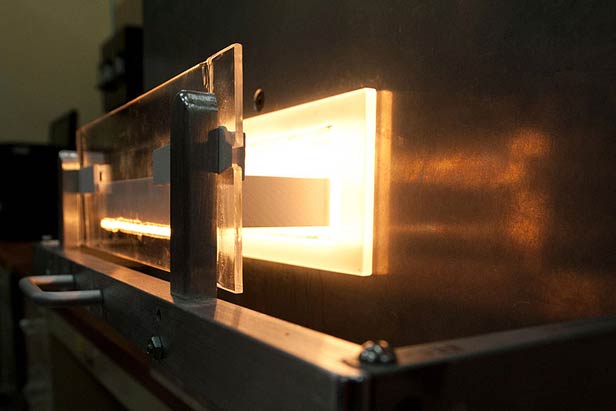A Brighter Way to Make Solar Cells

Making solar cells involves subjecting silicon wafers to temperatures in excess of 1,000 °C. The process normally involves the use of heating elements, and requires a lot of energy.
A new optical furnace developed by researchers at the National Renewable Energy Laboratory in Golden, Colorado, heats up solar wafers by focusing light on them—a much more efficient process that uses about half the energy of a conventional furnace. More importantly, the new design also uses light to remove certain impurities from the silicon wafers, a step that can improve the power output of finished cells.
The work is at an early stage—so far the researchers have only improved the efficiency of the resulting solar cells by half a percentage point. But based on lab tests, they think they can increase the efficiency by four percentage points, from about 16 percent efficient to 20 percent, which would be a big deal in the solar industry, which celebrates even half-a-percent increases.
High temperatures are needed at more than one step during solar-cell manufacturing. Furnaces are used to introduce dopants into the silicon to create electric fields within the material, to create electrical contacts, and to oxidize surfaces to improve efficiency. The new furnace also allows for better control of some of these processes, which can improve a solar cell’s efficiency.
NREL’s design isn’t the only one that uses light to process silicon. Rapid thermal processing furnaces, used in the microelectronics industry, also use light to heat up semiconductors. But the new furnaces use highly reflective and heat-resistant ceramics to ensure that the light is absorbed only by a silicon wafer, not by the walls inside the furnace. “That makes it many times more efficient,” says Bhushan Sopori, the researcher in charge of the furnace project at NREL.
By precisely designing the shape of the interior of the furnace, the researchers can control exactly where the light is focused, ensuring the wafers are heated evenly. It’s not enough to make sure the wafer is evenly illuminated—the edges have to receive more light because they lose heat more rapidly than the rest of the wafer.
The process reduces thermal stress on the wafers, and it allows for precise control over the chemical reactions that heating enables. Precise control of the rates and timing of the heating can also improve the electrical contacts on the solar cell, improving its efficiency. And it makes it practical to introduce an oxidation step. Oxidation has typically been used by only a few manufacturers for high-end solar cells, but the new process would make it cheaper and thus allow more manufacturers to use it.
Sopori says NREL has developed processes that take better advantage of photonic effects than the rapid thermal processing furnaces. As photons interact with the silicon, they can cause deleterious impurities such as iron to move out of the material, while keeping advantageous ones such as boron, which is needed for the solar cell to perform properly.
The researchers haven’t yet realized the complete four percentage point improvement in efficiency in part because the new processing steps aren’t all compatible with other steps in conventional manufacturing. Sopori says they are working to modify the other steps to take full advantage of the optical furnace.
NREL is also working with Advanced Optical Systems to develop a machine that can process not just one wafer at a time, as with the lab version, but up to 2,000. Such high throughput will be necessary if the furnaces are to compete with conventional ones, which are cheap to operate.
Keep Reading
Most Popular
Large language models can do jaw-dropping things. But nobody knows exactly why.
And that's a problem. Figuring it out is one of the biggest scientific puzzles of our time and a crucial step towards controlling more powerful future models.
The problem with plug-in hybrids? Their drivers.
Plug-in hybrids are often sold as a transition to EVs, but new data from Europe shows we’re still underestimating the emissions they produce.
Google DeepMind’s new generative model makes Super Mario–like games from scratch
Genie learns how to control games by watching hours and hours of video. It could help train next-gen robots too.
How scientists traced a mysterious covid case back to six toilets
When wastewater surveillance turns into a hunt for a single infected individual, the ethics get tricky.
Stay connected
Get the latest updates from
MIT Technology Review
Discover special offers, top stories, upcoming events, and more.